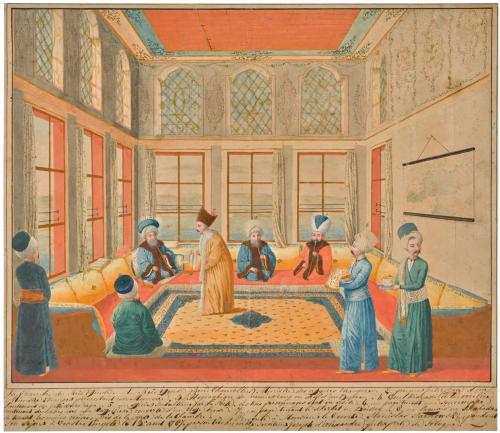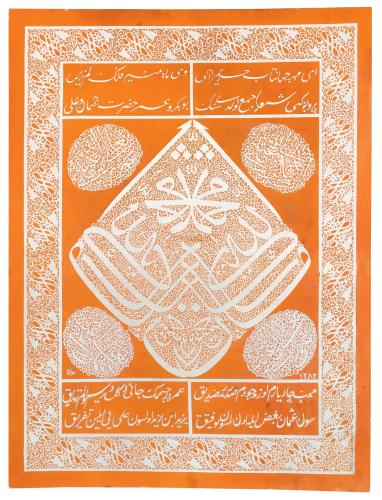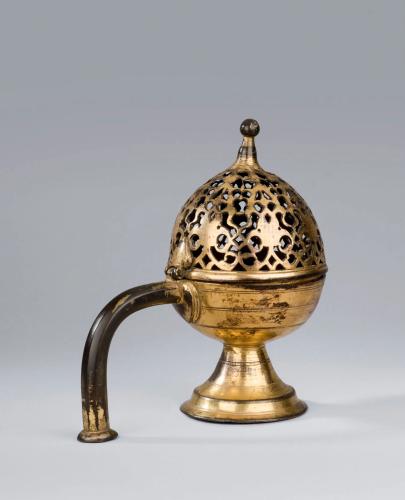
![Rare Ottoman Calligraphy [Qit‘a] Signed Mehmed Shehri](/sites/default/files/styles/large/public/object/2024-02-14/Rare%20Ottoman%20Calligraphy%20%5BQit%E2%80%98a%5D%20Signed%20Mehmed%20Shehri.jpg?itok=RwEwTYYi)
Price on application
This object is eligible for a Certificate of BADA Provenance
The BADA Standard
- Since 1918, BADA has been the leading association for the antiques and fine art trade
- Members are elected for their knowledge, integrity and quality of stock
- Our clients are protected by BADA’s code of conduct
- Our dealers’ membership is reviewed and renewed annually
- Bada.org is a non-profit site: clients deal directly with members and they pay no hidden fees
Rare Ottoman Calligraphy [Qit‘a] Signed Mehmed Shehri.
Ottoman Empire, First Half of the 18th Century, Signed Mehmed Shehrī (d.1740), Dimensions: 16 x 22.5 cm
Calligraphy in ten lines of naskh, and one line of large thuluth, with gold rulings, mounted on marbled paper.
This superb work by Mehmed Shehrī is based on a calligraphy by the famous Ottoman court master Sheikh Hamdullah (d. 1520).
This is an interesting example of the art of copying (naql) an early master’s work in Islamic calligraphy tradition, regarded as a sign of mastery among calligraphers. Works of great artists such as the Abbasid/Ilkhanid court calligrapher Yaqut al-Musta’simī (d. 1298) and the Ottoman court calligrapher Sheikh Hamdullah Efendi (d. 1520) were reproduced by many artists to prove their calligraphic skill and display their mastery.
Here, ‘Mehmed-i Shehrī’ (Mehmed of Istanbul [the nisba al-shahrī/shehrī was used by artists from Istanbul to indicate they were born in the Ottoman capital]) reproduced a work signed by Sheikh Hamdullah, now preserved in the Topkapi Palace Museum (inv. no. E.H. 2092), Istanbul, published in Muhiddin Serin’s Hattat Şeyh Hamdullah, Kubbealtı, Istanbul, 2007, p. 126.
When these two works are compared one can see that they are identical except for the last line which includes the signatures of Sheikh Hamdullah in the first and Mehmed Shehrī in the present calligraphy. The perfect execution of each nuance proves the mastery of Mehmed Shehrī in achieving the excellence of the prototype.
Unusually, in this work, Mehmed Shehrī didn’t use the expected classical phrase “nuqila min khatt Hamdullah al-ma‘ruf bi Ibn al-Shaikh…” (copied from the calligraphy of Sheikh Hamdullah).
Mehmed Shehri (d. 1740)
Mehmed Shehri, as indicated by his nisba “al-Shehri”, was born in Istanbul. He was also known as Usturacizade (razor-maker’s son). He studied thuluth and naskh scripts under the supervision of master Mehmed Giridi. According to Otttoman historian Mustakimzade Suleyman Saadeddin Efendi he was hard
of hearing. He was a follower of the famous Hafiz Osman Efendi (d. 1698) and wrote in his style. He was a member of one of the sufi orders in Istanbul. He died at the age of thirty-three years in 1740. He was buried in the Taksim cemetery. Please see: Şevket Rado’s Türk Hattatları, Tifdruk Press, Istanbul, 1980, p. 141 for detailed information about Mehmed Shehri’s career. His work is rare, and there do not seem to be any published examples in the standard literature.
The BADA Standard
- Since 1918, BADA has been the leading association for the antiques and fine art trade
- Members are elected for their knowledge, integrity and quality of stock
- Our clients are protected by BADA’s code of conduct
- Our dealers’ membership is reviewed and renewed annually
- Bada.org is a non-profit site: clients deal directly with members and they pay no hidden fees




